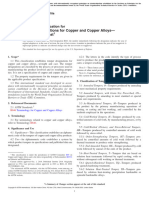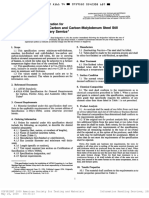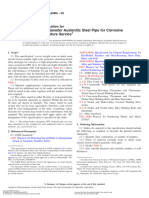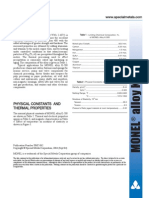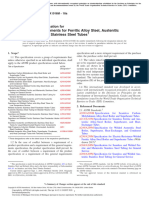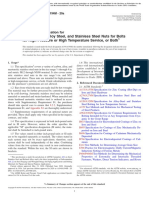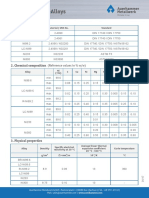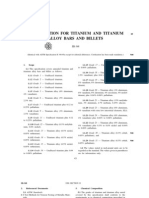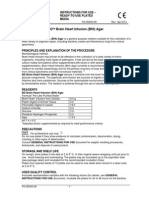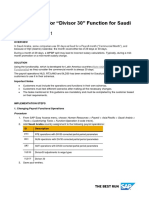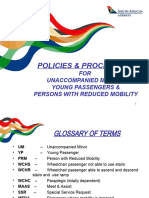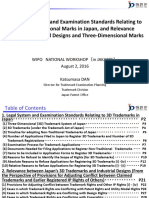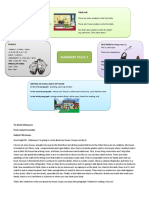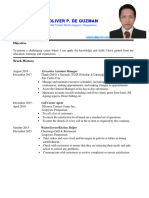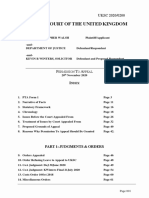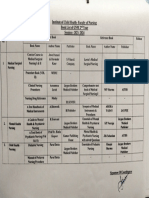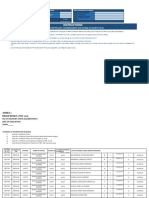Designation: A 729/A 729M – 09
Standard Specification for
Alloy Steel Axles, Heat-Treated, for Mass Transit and
Electric Railway Service1
This standard is issued under the fixed designation A 729/A 729M; the number immediately following the designation indicates the year
of original adoption or, in the case of revision, the year of last revision. A number in parentheses indicates the year of last reapproval.
A superscript epsilon (´) indicates an editorial change since the last revision or reapproval.
1. Scope* E 112 Test Methods for Determining Average Grain Size
1.1 This specification covers heat-treated alloy steel axles E 381 Method of Macroetch Testing Steel Bars, Billets,
for mass transit and commuter cars in electric and locomotive Blooms, and Forgings
hauled railway service. E 1426 Test Method for Determining the Effective Elastic
1.2 This specification is for solid design roller bearing axles Parameter for X-Ray Diffraction Measurements of Re-
with machined bodies. sidual Stress
1.3 Various axle designs are used for this service including 2.2 Other Standards:
motor and non-motor with either inboard or outboard journals. AAR Manual of Standards and Recommended Practices-
1.4 Supplementary requirements including those in the gen- Wheels and Axles3
eral requirements of Specification A 788/A 788M are provided 3. Ordering Information
for use when additional testing or inspection is desired. These
shall apply only when specified individually by the purchaser 3.1 Material supplied to this specification shall conform to
in the order. the requirements of Specification A 788/A 788M, which out-
1.5 Unless the order specifies the applicable “M” specifica- lines ordering information, manufacturing requirements, test-
tion designation, the axles shall be furnished to the inch-pound ing and retesting methods and procedures, marking, certifica-
units. tion, product analysis variations, and additional supplementary
1.6 The values stated in either SI units or inch-pound units requirements.
are to be regarded separately as standard. The values stated in 3.1.1 If the requirements of this specification are in conflict
each system may not be exact equivalents; therefore, each with the requirements of Specification A 788/A 788M, then the
system shall be used independently of the other. Combining requirements of this specification shall prevail.
values from the two systems may result in non-conformance 3.2 In addition to the ordering information required by
with the standard. Specification A 788/A 788M, the purchaser should include
with the inquiry and order a detailed drawing, sketch or written
2. Referenced Documents description of the axle showing complete details pertaining to
2.1 ASTM Standards:2 dimensions, tolerances if more restrictive than those contained
A 29/A 29M Specification for Steel Bars, Carbon and Alloy, in this specification, degree of finish, and location of stamping.
Hot-Wrought, General Requirements for 3.2.1 Unless the purchaser designates a class in the purchase
A 275/A 275M Practice for Magnetic Particle Examination order or contract, the class used shall be at the producer’s
of Steel Forgings discretion.
A 388/A 388M Practice for Ultrasonic Examination of 3.3 Supplementary requirements, if needed, including any
Steel Forgings that are appropriate from Specification A 788/A 788M.
A 788/A 788M Specification for Steel Forgings, General 4. Chemical Requirements
Requirements
4.1 Chemical Composition—The steel shall conform to the
chemical requirements specified in Table 1.
1
This specification is under the jurisdiction of ASTM Committee A01 on Steel, 4.2 Seven classes of steel are included in Table 1. Unless
Stainless Steel and Related Alloys and is the direct responsibility of Subcommittee otherwise specified by the purchaser, the choice of steel class to
A01.06 on Steel Forgings and Billets.
Current edition approved April 1, 2009. Published April 2009. Originally be used for any given axle grade is at the option of the
approved in 1976. Last previous edition approved in 2006 as A 729/A 729M – 06. producer.
2
For referenced ASTM standards, visit the ASTM website, www.astm.org, or
contact ASTM Customer Service at service@astm.org. For Annual Book of ASTM
3
Standards volume information, refer to the standard’s Document Summary page on Available from the Association of American Railroads, http://
the ASTM website. www.aarpublications.com/.
*A Summary of Changes section appears at the end of this standard.
Copyright © ASTM International, 100 Barr Harbor Drive, PO Box C700, West Conshohocken, PA 19428-2959, United States.
1
� A 729/A 729M – 09
TABLE 1 Chemical Requirements
Composition %
Class A Class B Class C Class DA Class F Classes G & H
Carbon 0.43-0.48 0.28-0.33 0.38-0.43 0.28-0.33 0.45-0.59 ...
Manganese 0.75-1.00 0.40-0.60 0.75-1.00 0.70 0.90 0.60-0.90 0.60-0.90
Phosphorous 0.035 max 0.035 max 0.035 max 0.035 max 0.035 max 0.035 max
Sulfur 0.040 max 0.040 max 0.040 max 0.040 max 0.040 max 0.040 max
Silicon 0.15-0.35 0.15-0.35 0.15-0.35 0.15-0.35 0.15 min 0.15 min
B B
Nickel ... ... ... 0.40-0.70
B B
Chromium 0.20-0.35 0.80-1.10 0.80-1.10 0.40-0.60
B B
Molybdenum ... 0.15-0.25 0.15-0.25 0.15-0.25
B B
Vanadium 0.08 max 0.08 max 0.08 max 0.08 max
B B
Aluminum 0.04 max 0.04 max 0.04 max 0.04 max
A
Class D meets the requirements of SAE 8630 alloy steel.
B
The manufacturer may add these elements as necessary to meet the specified mechanical properties after the required heat treatment. The actual chemistry shall be
reported.
4.3 Classes F, G, and H are referenced in the AAR Manual 500°F [260°C]. A furnace charge thus treated is termed a
of Standards and Recommended Practices and unspecified double normalizing charge. After cooling, the axles are then
element additions to these classes shall be reported. tempered as in 5.3.4.
4.4 The purchaser may use the requirements of Specifica- 5.3.3 All other Grades shall be liquid quenched and tem-
tion A 788/A 788M for a product analysis. pered. After heating to and holding at an appropriate tempera-
ture in the austenitic range, the axles shall be quenched in a
5. Manufacture suitable medium. A furnace charge thus treated is termed a
5.1 Forging Practice—The axle may be made direct from quenching charge. Following quenching, the axles are tem-
the ingot or from blooms, the total reduction in cross-sectional pered as in 5.3.4.
area from ingot or strand cast blooms to axle forging being not 5.3.3.1 Grade H axles require a normalizing cycle prior to
less than 3 to 1, unless otherwise specified. the quenching heat treatment.
5.2 Cooling and Heating:
5.3.3.2 At the manufacturer’s option for Grade G, a normal-
5.2.1 Blooms shall be reheated for forging in a manner that
izing cycle may precede austenitizing for the liquid quenching
will prevent internal bursts and overheating.
5.2.2 Axles that are heat-treated directly from forging shall operation.
be cooled below the transformation temperature to at least 5.3.4 Tempering—Axles shall be reheated gradually to and
1000°F [538°C] before any reheating operation. held at an appropriate subcritical temperature, and shall then be
5.3 Heat Treatment: allowed to cool under uniform conditions. A furnace charge
5.3.1 Axles shall be heat-treated in accordance with Table 2. thus treated is termed a tempering charge.
5.3.2 Grades A and F shall be heat-treated by double 5.3.4.1 When required by supplementary requirement S2,
normalizing, followed by tempering. After heating to and axles that have been rough machined after heat treatment shall
holding at an appropriate temperature in the austenitic range, be heated to and held for an appropriate time at a temperature
the axles shall be cooled in still air to under 500°F [260°C]. that is less than the last tempering temperature by at least 50°F
They shall then be reheated into the austenitic range to the [10°C]. Then the axles shall be quenched directly into water
same or a lower temperature and again air cooled to under with the axle length vertical.
TABLE 2 Heat Treatment and Tensile Requirements
Yield Strength
Tensile Strength, Elongation, in Reduction of
Grade Heat Treatment Size, Solid Diameter or Thickness, in. [mm] @ 0.2 %, min,
psi [MPa], min 2 in. [50 mm], min Area %, min
psi [MPa]
Over Not Over
A, F Double Normalize ... 8 [200] 88 000 [605] 50 000 [345] 22 37
and Temper 86 000 [595] 48 000 [330] 21 35
8 [200] 12 [300]
... 4 [100] 105 000 [725] 70 000 [485] 24 45
Quench 4 [100] 7 [175] 100 000 [690] 65 000 [450] 22 45
B, C, D
and Temper 7 [175] 10 [250] 85 000 [585] 50 000 [345] 20 40
10 [250] ... 82 500 [570] 48 000 [330] 19 35
... 4 [200] 90 000 [620] 55 000 [380] 20 39
Quench
G 4 [100] 7 [175] 85 000 [585] 50 000 [345] 20 39
and Temper
7 [175] 10 [250] 85 000 [585] 50 000 [345] 19 37
Normalize, Quench, ... 7 [175] 115 000 [795] 75 000 [520] 16 35
H
and Temper 7 [175] 10 [250] 105 000 [725] 65 000 [450] 18 35
2
� A 729/A 729M – 09
5.3.5 Heat treatment may be performed in either batch-type no more than 70 axles. The axles represented by this test shall
furnaces or continuous furnaces. be called a heat-treatment lot.
5.4 Straightening—Straightening, if necessary, shall be 7.3.3 Where continuous heat-treating furnaces are used, one
done before machining and preferably at a temperature not test per heat per size classification is required, but each test
lower than 950°F [510°C]. Straightening, performed at tem- shall represent no more than 70 axles. The axles represented by
peratures lower than 950°F [510°C], shall be followed by stress this test shall be called a heat-treatment lot.
relieving or applicable heat treatment. 7.4 Retest:
7.4.1 If the results of the mechanical tests of any lot do not
6. Metallurgical Requirements conform to the requirements specified, the axles may be
6.1 A specimen, representing each heat in each heat- retreated, but not more than three additional times and retests
treatment lot, shall be taken for the heat treated grain size shall be made in accordance with Section 7.
determination in accordance with Test Methods E 112. This 8. Nondestructive Testing Requirements
sample section may be cut from the large undistorted portion of
the tension test specimen in such a way as will give a face 8.1 Ultrasonic Examination—The purpose of this examina-
transverse to the axis of the axle. tion is to evaluate the quality of new axles (1) by determining
6.2 The entire specimen shall show a uniform, fine-grained end face to end face penetrability, and (2) by detecting
structure of No. 5 or finer as measured in accordance with Test discontinuities that may be harmful to axle service.
Methods E 112. 8.2 Method—The axle examination shall conform to Prac-
6.3 Alternatively, the austenitic fine grain requirements of tice A 388/A 388M.
Specification A 29/A 29M may be used in lieu of the heat- 8.3 Time of Examination—Examination shall be made after
treated grain size described in 6.1. In this case, the grain heat treatment and after the axle end faces have been machined
refining elements used shall be included in the heat analysis square, and preferably before being centered.
results. 8.4 Instrument Sensitivity and Scanning:
8.4.1 Instrument Sensitivity:
7. Tension Test Requirements 8.4.1.1 The instrument sensitivity shall be adjusted to pro-
duce an indication of 20 % full screen height (FSH) from a
7.1 Tension tests shall be taken from the test prolongation or reference test block manufactured from a representative heat-
from an axle in accordance with 7.2. treated axle forging having a 1⁄8-in. [3.20-mm] diameter, 1 in.
7.1.1 Axles shall conform to the requirements in Table 2. [25.4 mm] deep, flat-bottomed hole drilled perpendicularly to
7.1.2 The diameter of the test prolongation of axle forgings and at a distance of 15 in. [381 mm] from the test end face of
shall be determined by the forged diameter of the journal. the axle section. The reference blocks shall have a surface
7.1.3 Tests shall be made only after final heat treatment. finish of 80 to 125 µin. [2.03 to 3.20 µm] and detect in
7.1.4 The longitudinal axis of the specimen shall be located reference axles a flat-bottom hole of the size and distance
at any point midway between the center and surface of the axle specified in the table below.
or full-sized prolongation and shall be parallel to the axis of the 8.4.1.2 At the sensitivity established in 8.4.1.1, the instru-
axle. ment shall be capable of detecting a flat bottom hole of the size
7.2 Prolongation: and distance specified below:
7.2.1 To ensure that sufficient material is available for test
Minimum Size (Flat-Bottom Holes) Detectable at Various Distances
purposes, prolongations shall be attached to at least 5 % of the from End Faces
axles in each heat in each heat-treating lot.
Test Distance to 15 Test Distance 15 to 30 in. Test Distance over
7.2.2 If axles with prolongations have been expended, then in. [381 mm] [381 to 762 mm] 30 in. [762 mm]
axles may be used for test procurement.
7.3 Number of Tests: 1⁄8 in. 1⁄4 in. 3 ⁄8 in.
[3.20 mm] [6.35 mm] [9.52 mm]
7.3.1 Unless otherwise specified by the purchaser, mechani-
cal tests shall be made as covered in 7.3.2 and 7.3.3. 8.4.2 Scanning:
7.3.2 Where batch-type furnaces are used, one test per heat 8.4.2.1 Scanning shall be performed from both end faces,
per size classification is required, but each test shall represent which shall have a surface finish of 125 µin. [3.20 µm]
FIG. 1 Typical Distance-Amplitude Curve for a Heat-Treated Axle Using a 11⁄8-in. [28.6-mm] Diameter 2.25-MHz Quartz Transducer
3
� A 729/A 729M – 09
FIG. 2 Location of Reference Holes in an Axle—Flat Bottom Hole Sizes for a Heat-Treated Axle
maximum and, when specified, from the OP. The scanning 8.7.2 Spurious Ultrasonic Indications from Contour
shall include the maximum end face area obtainable by manual Variations—Because an axle varies in cross section it is
or automated inspection techniques. possible to produce spurious indications, particularly at
8.4.2.2 During scanning the amplitude of the indication changes of cross section. These must be recognized, and are
from the end face opposite the search unit shall be monitored not reason for rejection. It is not practical to define these
and the amplitudes of all discontinuity indications shall be indications as responses from axle contours.
evaluated with respect to the distance from the test surface (see 8.7.3 Near-Field Resolution—It should be recognized that
8.4.3 and 8.7.2). detection of discontinuities near the test surface is limited by
8.4.3 Distance-Amplitude Correction—The amplitude of an the ultrasonic test frequency. In the case of quenched and
ultrasonic indication must be considered in relation to its tempered axles, this is approximately 1 in. [25.4 mm] from the
distance from the testing surface to evaluate its significance. test surface.
This can be accomplished by an electronic device or by
distance-amplitude curves (DAC), which are described in 9. Magnetic Particle Examination
8.7.2. 9.1 Magnetic particle examination of finish machined axles
8.4.4 In addition to the reportable conditions of Practice shall be done in accordance with Practice A 275/A 275M.
A 388/A 388M, indications exceeding the resulting back re- 9.2 Acceptance shall be in accordance with Annex A1.
flection shall be reported.
8.5 Acceptance: 10. Dimensional Tolerances
8.5.1 Longitudinal Penetration—Axles that do not produce 10.1 Length and Diameter:
a 40 % FSH back reflection from the end of face opposite the 10.1.1 For axles ordered to finished length, the overall
search unit shall be rejected or made acceptable by heat length shall not be less than the specified minimum length nor
treatment. more than 1⁄16 in. [1.6 mm] over.
8.5.2 Discontinuity Test—The axle shall be rejected if the 10.1.2 For axles ordered for finished-end facing by the
amplitude of any discontinuity indication exceeds the indica- purchaser, the overall length shall range from 1⁄8 in. [3.2 mm]
tion levels obtained from the flat-bottom holes listed in the to 1⁄4 in. [6.4 mm] over the specified minimum length.
table under 8.4.1.2 considering the distance-amplitude correc- 10.1.3 For any other axles ordered to final length and not
tion as described in 8.4.3. covered by the above classifications, the overall length shall
8.5.3 Radial Scan—An axle forging shall be unacceptable if not be less than the specified minimum length nor more than 1⁄8
from the radial scan from the OP one or more reflections are in. [3.2 mm] over.
present producing indications accompanied by complete loss of 10.1.4 The specified minimum length shall be the nominal
back reflection not attributable to geometric configuration. For overall final length less any allowable tolerances.
this purpose, a back reflection of less than 5 % of full screen 10.1.5 Rough-machined areas, either the entire axle or
height shall be considered loss of back reflection. designated parts thereof, shall be 1⁄8 in. [3.2 mm] to 1⁄4 in.
8.6 Marking—Axles that meet the ultrasonic inspection [6.4 mm] over the finished diameter; in the case of motor axles
requirements of this specification shall be stamped with the having a conglomerate of diameters for the seats for wheel,
letter “T” on the end face adjacent to the heat number or serial gear, gear case bearing, and grounding ring the entire area shall
number. be rough machined to a single diameter 1⁄8 to 1⁄4 in. [3.2 to
8.7 Additional Information: 6.4 mm] over the finished diameter of the segment having the
8.7.1 Amplitude Correction—The amplitude of an ultra- largest diameter. Longitudinally 1⁄8 to 1⁄4 in. [3.2 to 6.4 mm] of
sonic indication from a given discontinuity size varies with its metal shall be allowed at each change of cross section for finish
distance from the test surface. To compensate for this effect, a machining.
distance-amplitude relationship is employed. The relationship 10.1.6 The smooth-machined body shall be to the specified
can be established by an electronic device or by curves. size with no more than 1⁄8 in. [3.2 mm] over on the diameters
Because the distance-amplitude relationship is influenced pri- and shall have no more than 1⁄8 in. [3.2 mm] allowance
marily by the ultrasonic transducer and instrument, it is longitudinally at each change of cross section.
necessary to relate this factor to the specific equipment used.
Appropriate distance-amplitude curves shall be developed. A 11. Workmanship and Finish
typical example is shown in Fig. 1 as related to the axle in Fig. 11.1 Axles shall conform to the size, shape, and finish
2. shown on the purchaser’s drawing and unless otherwise
4
� A 729/A 729M – 09
specified shall have center holes with clearance drilled for lathe letters and figures not less than 1⁄4 in. [6.4 mm] high. This
center points and not counter bored. All machining shall be stamping shall be on the end face or under cut shoulder at the
done in a workmanlike manner. end of the journal as shown on the purchaser’s drawing. It
11.2 Where a smooth-machined finish on the body (10.1.6) should include month and year made, manufacturer’s name or
is specified, it shall be to a maximum of 250 µin. [6.35 µm]. trademark, heat number, and serial number.
Rough machining shall be free of excessively rough ridges and 12.2 In addition to the above required markings, bar code
coarse chatter marks. tags may be applied to the axles. If these tags are applied, it is
11.3 Finish machined axle surfaces shall be free of injurious recommended that Bar Code 39 be used. The size and location
imperfections as defined in Annex A1. of the tags, as well as the information to be included, shall be
agreed upon by the purchaser and the manufacturer.
12. Product Marking
12.1 In addition to the marking requirements of Specifica- 13. Keywords
tion A 788/A 788M, axles shall be legibly cold-stamped with 13.1 axles; rail applications; steel forgings
SUPPLEMENTARY REQUIREMENTS
The following supplementary requirement shall apply only when specified by the purchaser. Details
shall be agreed upon by the manufacturer and the purchaser.
S1. Macroscopical Tests [480°C]. Sufficient allowance shall be left in the rough ma-
S1.1 The prolongation from the largest axle in each heat chined billet so that the axle can be machined to final
shall be sawed normal to the axis of the axle and shall then be dimensions after sub-critical quench.
split longitudinally. The transverse and the longitudinal faces
shall be etched for macro examination in accordance with S3. Residual Stress Measurement
Method E 381. S3.1 When specified, fee residual compressive stresses shall
S1.2 Acceptance criteria shall be based on the adjuncts of
be measured in the body section of one representative axle.
Method E 381 as specified in the purchase order.
X-ray diffraction residual stress measurements to Test Method
S2. Accelerated Cooling after Stress Relief E 1426 shall be considered the standard method.
S2.1 When specified, the rough machined axle shall be S3.2 The results shall be reported.
given a sub-critical quench from a temperature above 900°F
ANNEX
(Mandatory Information)
A1. INTERPRETATION OF IMPERFECTIONS CONSIDERED INJURIOUS IN AXLES
A1.1 General negotiations between representatives of the manufacturer and
A1.1.1 The conditions that have been most difficult for the purchaser who are especially qualified to decide such
inspectors to evaluate are light lines visible to the normal questions.
unaided eye, variously described as actual seams, hairlines, A1.1.3 Any transverse or circumferential seams, cracks, or
stringers, shadow seams, ghost lines, and so forth, which laps of indeterminate depth on the axle surfaces other than the
appear after the axles have been finish machined and burnished discolorations listed in A1.1.4 regardless of their location, are
or ground. It is, therefore, advisable to describe these condi- considered to be injurious and are cause for rejection without
tions in more detail. further machining.
A1.1.2 The interpretation of injurious imperfections as enu- A1.1.4 Ghost lines, shadow marks, or other similar discol-
merated below is not to be considered as precluding other
orations, visible to the normal unaided eye that are not actual
unforeseen or objectionable conditions not specifically listed.
separations in the metal are not considered injurious regardless
The right of the purchaser is reserved to reject temporarily such
of location.
axles and make final settlement on the basis of further
5
� A 729/A 729M – 09
A1.1.5 Any longitudinal discontinuity, variously termed A1.3.1.1 Must not extend within 11⁄2 in. [38.1 mm] of either
hairline, stringer, or fine seam, in machined fillets is considered end of the seats covered in this section.
to be injurious and is cause for rejection without further A1.3.1.2 Must not be over 1⁄2 in. [12.7 mm] long individu-
conditioning. ally.
A1.3.1.3 Total length of such imperfections, 1⁄4 in.
A1.2 Journals and Dust Guards
[6.4 mm] to 1⁄2 in. [12.7 mm] long, must not exceed 3 in.
A1.2.1 Fine longitudinal discontinuities on the finished [76.2 mm] in any one end of the axle.
(burnished or ground) surfaces variously termed hairlines,
stringers, or fine seams are not considered injurious if they A1.4 Areas Between Attachment Seats (Body) Specified
meet the following conditions: to Be Smooth Machined
A1.2.1.1 Must not extend into fillets.
A1.2.1.2 Must not be over 3⁄4 in. [20 mm] long individually A1.4.1 Longitudinal discontinuities on the smooth ma-
in the journal nor 1⁄2 in. [12.7 mm] long individually in the chined body, variously termed hairlines, stringers, or fine
dust-guard seat. seams, are not considered injurious if they meet the following
A1.2.1.3 Total length of such imperfections over 1⁄4 in. conditions:
[6.4 mm] long must not exceed 2 in. [50.8 mm] in any one end A1.4.1.1 Must not extend into fillets at the ends of the body,
of the axle. A1.4.1.2 Must not be over 1⁄2 in. [12.7 mm] long individu-
ally,
A1.3 Wheel Seats, Gear Seats, Gear Case Bearing Seat, A1.4.1.3 Total length of such imperfections, 1⁄4 in. [6.4 mm]
and Grounding Ring Seats to 1⁄2 in. [12.7 mm] long, must not exceed 11⁄2 in. [38.1 mm] in
A1.3.1 Longitudinal discontinuities on the finished- any 12 in. [305 mm] of body length, and
machined surface of wheel and gear seats, variously termed A1.4.1.4 Axles containing longitudinal discontinuities in
hairlines, stringers, fine seams, tight seams, surface imperfec- the body in excess of those described in A1.4.1.2 and A1.4.1.3
tions, and so forth, are not considered injurious if they meet the may be reconditioned by grinding or machining provided the
following conditions: diameter is not reduced below the specified minimum.
APPENDIX
(Nonmandatory Information)
X1. COMPOSITIONS FOR AXLE APPLICATIONS
X1.1 For the guidance of the purchaser, typical standard Grade Standard Composition
compositions that cloud be used for axle applications are listed Specification A 29/A 29M
B 4130
below, however the diameter of the axle at the time of heat C 4140
treatment must be taken into account when selecting the D 8630
forging composition.
SUMMARY OF CHANGES
Committee A01 has identified the location of selected changes to this standard since the last issue
(A 729/A 729M – 06) that may impact the use of this standard. (Approved April 1, 2009.)
(1) Added AAR Manual of Standards and Recommended (2) Revised Table 2.
Practices to Section 2.
6
� A 729/A 729M – 09
ASTM International takes no position respecting the validity of any patent rights asserted in connection with any item mentioned
in this standard. Users of this standard are expressly advised that determination of the validity of any such patent rights, and the risk
of infringement of such rights, are entirely their own responsibility.
This standard is subject to revision at any time by the responsible technical committee and must be reviewed every five years and
if not revised, either reapproved or withdrawn. Your comments are invited either for revision of this standard or for additional standards
and should be addressed to ASTM International Headquarters. Your comments will receive careful consideration at a meeting of the
responsible technical committee, which you may attend. If you feel that your comments have not received a fair hearing you should
make your views known to the ASTM Committee on Standards, at the address shown below.
This standard is copyrighted by ASTM International, 100 Barr Harbor Drive, PO Box C700, West Conshohocken, PA 19428-2959,
United States. Individual reprints (single or multiple copies) of this standard may be obtained by contacting ASTM at the above
address or at 610-832-9585 (phone), 610-832-9555 (fax), or service@astm.org (e-mail); or through the ASTM website
(www.astm.org).
7
�主营业务范围:ASTM
ASTM NAS
ASTM、NAS NASM
NAS、NASM MIL
NASM、MIL ISO
MIL、ISO EN
ISO、EN DIN
EN、DIN
DIN、
JIS 等技术标准翻译;技术资料翻译;国外技术标准中文版代购;
NADCAP 认证标准翻译等。
业务 QQ 2298175560
QQ:2298175560














